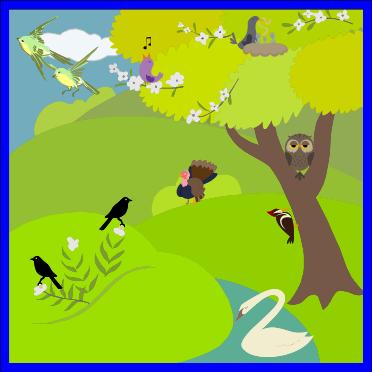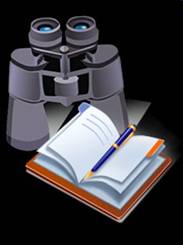Field Ornithology
EEB 4262: Field Methods in Ornithology
Intensive Summer Session, May 8th - 26th, 2015
Meets: M-F, 7:30 am to 11:30 am, TLS 371
Instructor: Holly K. Milton Brown
Office: Pharmacy Biology Building, room 402
Email: holly.k.brown@uconn.edu
Office hours: flexible (email to set up an appointment)
Websites: UCONN website Wordpress
Course Objectives
Upon completion of this course, students will have:
1. acquired bird identification skills (by sight and sound).
2. become proficient in taking scientific field notes.
3. gained experience in common field techniques for studying birds.
4. contributed to the design and implementation of a group research project.
Course Materials
Required
1. The Sibley Field Guide to the Birds of Eastern North America
2. Bibby CJ, Burgess ND, Hill DA, Mustoe S, editors. 2000. Bird census techniques. San Diego, USA: Academic Press
3. Binoculars (available from us if you don’t have any)
4. Field notepad/notebook (![]() Basic guidelines)
Basic guidelines)
5. Closed-toe shoes (no sandals) or hiking boots, & proper outdoor clothing (you may encounter poison ivy, ticks and biting insects, and/or bad weather)
Strongly Recommended
1. Peterson's Birding by Ear: Eastern and Central North America
2. Peterson's More Birding by Ear: Eastern and Central North America
3. Insect repellent (ticks, mosquitoes)
4. Sunscreen
Tentative schedule - Note that because so much of what we do depends on the weather, the schedule is very subject to change! Also note that Pop Quizzes are possible on any date.
| Day | Topic | Day | Topic | Day | Topic |
|---|---|---|---|---|---|
| M 8 | Course intro: syllabus, schedule, field safety; Intro to bird ID (Optics, Guides and Notes); Survey local birds; Read Bibby Ch 1 PRIOR to class | M 15 | Group project proposal presentations & project selection; Start projects; Submit field notebooks for grading | M 22 | Finish data collection; Start data analysis |
| T 9 | NOTE: THIS CLASS WILL RUN 9AM-1PM. Bird Topography and Field Marks; Banding Demonstration Field Trip | T 16 | Data collection | T 23 | Survey of coastal birds |
| W 10 | Field research techniques, study design, and data analysis | W 17 | MIDTERM EXAM; Data collection | W 24 | Survey of local, off-campus birding sites; Submit field notebooks for a final notebook grade |
| Th 11 | Field techniques, continued; Survey local birds | Th 18 | Report on state of group research project; Discuss methodological revisions; Data collection | Th 25 | Research Presentations (& birding afterwards) |
| F 12 | Research project guidelines & discussion; Survey local birds | F 19 | Data collection | F 26 | FINAL EXAM; Peer evaluations; Instructor evaluations |
Grading
Exams: May 17th (MIDTERM) [50 points]; May 26th (FINAL) [50 points]
Pop Quizzes: 5 (10 points each) [50 points]
Research Project Proposal (Presentation & Discussions): May 15th [50 points];
Research Project Presentation: May 25th [50 points];
Field Notebook Submissions: May 15th (First) [25 points]; May 26th (Final) [25 points]
Field trips and birding exercises (5 points each): Dates will be weather dependent [35 points]
Total: [335 points]
Grading scale: A = 100-90%, B = 89-80%, C = 79-70%, D = 69-60%, F = 59-0%.
Plus/minus system will be used for the final grade.
Additional References & Websites
• Local Birds ID tool: http://www.whatbird.com/Expert/Expert.aspx
• MANUAL OF ORNITHOLOGY (Yale Univ.), by N.S. Proctor and P.J. Lynch: http://books.google.com/books?id=nQ3vLQkEWQMC&printsec=frontcover&dq=general+warbler+bill+shape#v=onepage&q&f=false
• Bibby CJ, Burgess ND, Hill DA, Mustoe S, editors. 2000. Bird census techniques. San Diego, USA: Academic Press.: http://books.google.com/books?id=Ld5wkzPp49cC&printsec=frontcover&dq=Bibby&ie=ISO-8859-1&cd=2&source=gbs_gdata#v=onepage&q&f=false
• Gill F. 2007. Ornithology. New York: W. H. Freeman and Company. : http://books.google.com/books?id=zM0tG5ApO0UC&printsec=frontcover&dq=ornithology+gill&hl=en&src=bmrr&ei=4iTsTfHvN4b2gAeg3o3ZCQ&sa=X&oi=book_result&ct=result&resnum=1&ved=0CC4Q6AEwAA#v=onepage&q&f=false
• Stiling P. 1999. Ecology: theories and application. New Jersey: Prentice Hall.
• Clark, G. A. 1999. Birds of Storrs, Connecticut and vicinity. 3rd Ed. Mansfield, CT: Natchaug Ornithological Society & Joshua’s Tract Conservation and Historic Trust.
• SORA (Searchable Ornithological Research Archive): http://elibrary.unm.edu/sora/index.php
• Cornell Lab of Ornithology “All About Birds”: http://www.birds.cornell.edu/AllAboutBirds
• Natchaug Ornithological Society: http://www.nosbird.org/ (esp. “local hotspots” http://www.nosbird.org/hotspots.html)
• Connecticut Ornithological Association: http://www.ctbirding.org/index.htm
• CT Audubon Society: http://www.ctaudubon.org/
• CT Department of Environmental Protection: http://www.ct.gov/dep/site/default.asp
Website design by Diego Sustaita

